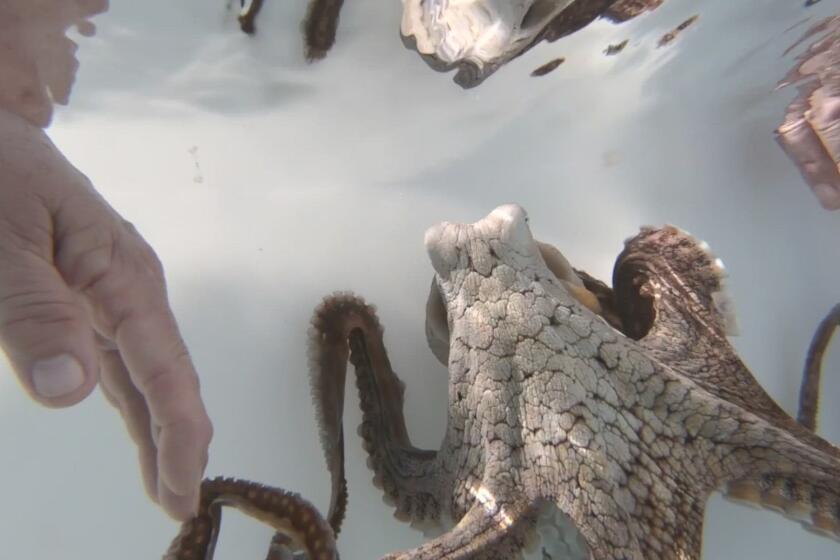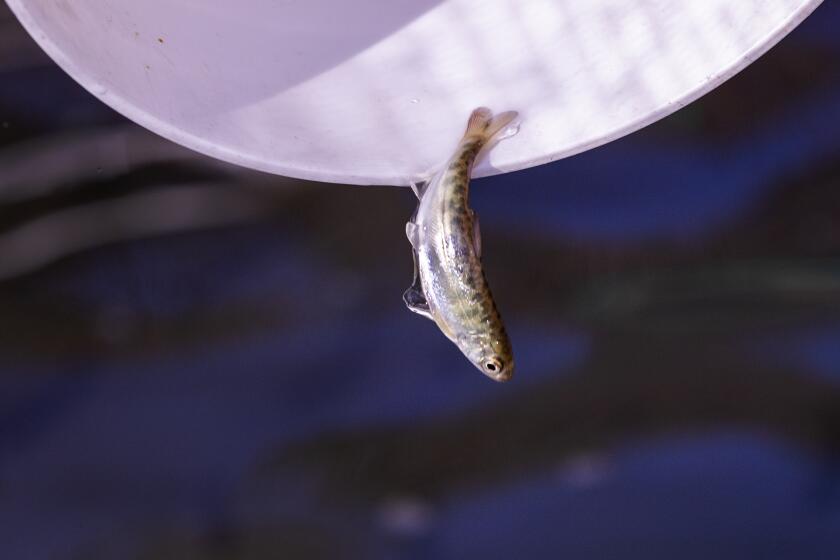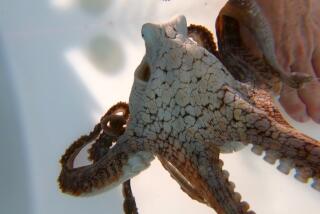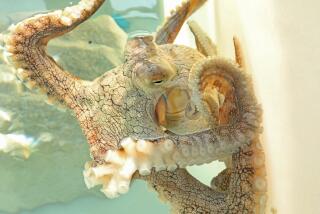Hawaii orders facility to stop capturing and keeping octopuses
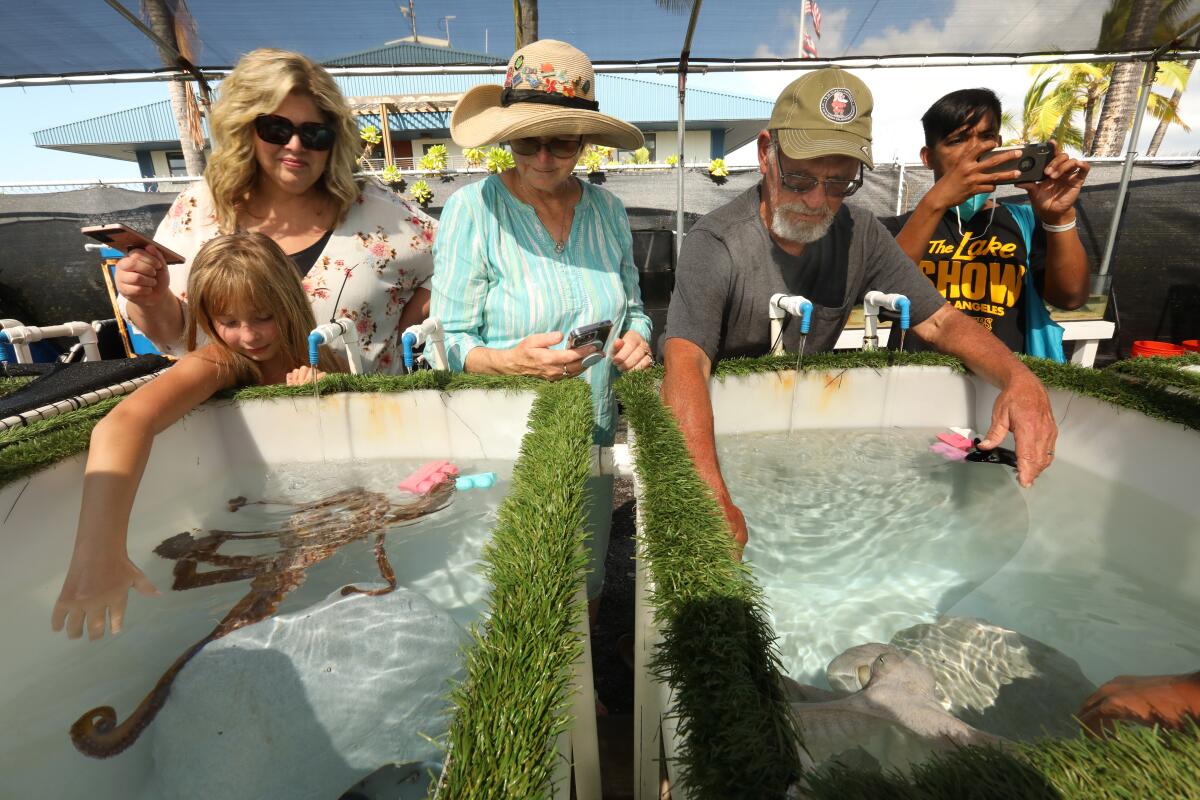
- Share via
The owner of a controversial octopus “farm” on Hawaii’s Big Island was ordered to “cease and desist” nonpermitted operations in January after a clamor of attention was directed at the small outfit, which charges visitors $60 for the opportunity to touch a wild-caught day octopus.
The Kanaloa Octopus Farm, in Kailua-Kona, generally holds between 15 and 20 octopuses at a time in separate, opaque 100-gallon tanks, which resemble big sinks, where the captured animals remain — with an occasional visit to a larger “reef” tank — until they die. Day octopuses generally live for about one year.
Until the state’s Jan. 6 letter was received by Kanaloa, operators offered three 20-person tours a day, seven days a week, for visitors and tourists to interact with the octopuses.
The letter, which was written by Brian Neilson, administrator of Hawaii’s Division of Aquatic Resources, informed owner Jacob Conroy that the business was in violation of state law by possessing and breeding a “regulated species of aquatic life without the required permits.” In addition, it is unlawful to possess individual day octopuses that weigh less than 1 pound and which were taken from within the West Hawaii Regional Fishery Management Area without a permit.
Conroy said in an email to The Times that he was working with the state to make sure the facility is in full compliance; he disputed the claims.
A business in Hawaii is trying to close the life cycle of the octopus. Should it?
He said the Kanaloa Octopus Farm does “not work with Day Octopuses under one pound” and “most of our octopuses are sourced from local fishermen who would otherwise sell them for use as bait. Our octopuses are typically injured animals that others don’t want. We feed them and care for them, allowing them to recover.”
But a second letter was sent to Conroy on Jan. 18, after facility manager Dan Jackson did an interview with Hawaii Public Radio on Jan. 13 in which he seemed to contradict these denials.
“I think the smallest we got was 0.8 grams — it’s about the size of the tip of my pinky finger,” he told the radio interviewer. “And so we’ve been able to raise them up to adults from, you know, less than a gram and then have them successfully reproduce.”
He said most of their octopuses are caught by “a gentleman who actually catches them for us. He’s just really good at it. He just knows how to find octopus. Some people can just find them better than others.”
Other octopuses, he said, come in to the Natural Energy Laboratory of Hawaii Authority, the state-sponsored aquaculture site where the business is located, via large water intake pipelines “that are sucking up thousands and thousands of gallons per minute ... and every once in a while, a little juvenile octopus will get sucked up that pipeline.”
Conroy told The Times via email that Jackson was referring to crescent octopuses, an unregulated species, which are not on display at Kanaloa.
Conroy also said the fisherman Jackson referred to only caught octopuses outside the West Hawaii Regional Fishery Management Area — an area of water that runs along the western coast of the Big Island from the high-water mark on shore to the limit of the state’s management authority.
Madison Rice, a spokesperson for the state, said Conroy will have to apply for a “special activities” permit in order to continue operating with live octopuses. This permit allows a person to “take [or possess] aquatic life ... otherwise prohibited by law ... for scientific, educational, management or propagation purposes.”
“There is no guarantee that an application for a Special Activities Permit will be approved,” wrote Neilson, in the second letter.
Winter-run Chinook salmon numbers are at the lowest they’ve ever been. But scientists say it’s not because of high temperatures or the historic drought. Instead, they say, it’s their diet.
The Kanaloa Octopus Farm is currently closed to the public. Despite its name, operators describe the business as a research facility and say they are not raising octopuses for food.
The business has come under criticism from animal rights activists and octopus researchers for its treatment of the day octopus — a creature scientists describe as curious, intelligent and playful. They say the operation is little more than a petting zoo in which wild-caught animals are confined for life and used to entertain humans.
Conroy and Jackson say their goal is to learn how to breed day octopuses, which are not endangered, so that “in case anything ever does happen to the populations,” wildlife officials across the globe can restock them, Jackson said during his radio interview.
So far, no one has been able to close the life cycle of potentially commercially productive captive octopuses. While Kanaloa and some commercial octopus farms have been able to produce viable larvae from eggs fertilized in captivity, they have not been able to keep those small octopuses living beyond 13 days.
It’s a problem that has vexxed several commercial operations that hope to breed octopuses in captivity for food, including the Spanish company Nueva Pescanova and Japan’s Nippon Suisan Kaisha, or Nissui.
Washington state Rep. Strom Peterson has introduced legislation in his state that would ban octopus farming.
“Washington should be on the forefront in the U.S. and globally in the protection of sentient octopuses from these dreary and oppressing conditions that await them in the burgeoning farmed octopus industry,” said Josh Diamond, a member of the Animal Rights Initiative.
There was no opposition to the bill, and the committee will vote on whether to move it forward on Friday.
There are no federal or state protections for octopuses.
More to Read
Sign up for Essential California
The most important California stories and recommendations in your inbox every morning.
You may occasionally receive promotional content from the Los Angeles Times.
